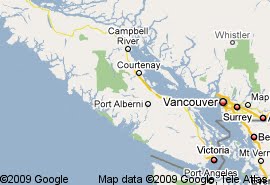http://www.commondreams.org/view/2010/05/26-S
Published on Wednesday, May 26, 2010 by Civil Eats
Beeline to Extinction
by Naomi Starkman
According to the recently released annual survey by the Apiary Inspectors of America(AIA) and the Agricultural Research Service (ARS), more than a third of U.S. managed honeybee colonies-those set up for intensified pollination of commercial crops-failed to survive this past winter. Since 2006, the decline of the U.S.'s estimated 2.4 million beehives-commonly referred to as colony collapse disorder (CCD)-has led to the disappearance of hundreds of thousands of colonies: Hives are found empty with honey, larvae, and the queen intact, but with no bees and no trail left behind. The cause remains unknown, but appears to be a combination of factors impacting bee health and increasing their susceptibility to disease. Heavy losses associated with CCD have been found mainly with larger migratory commercial beekeepers, some of whom have lost 50-90 percent of their colonies.
A "keystone" species-one that has a disproportionate effect on the environment relative to its biomass-bees are our key to global food security and a critical part of the food chain. Flowering plants that produce our food depend on insects for pollination. There are other pollinators-butterflies, moths, beetles, flies, and birds-but the honeybee is the most effective, pollinating over 100 commercial crops nationwide, including most fruit, vegetables, and nuts, as well as alfalfa for cattle feed and cotton, with a value estimated between $15-$20 billion annually. As much as one of every three bites of food we eat comes from food pollinated by insects. Without honeybees, our diet would be mostly meatless, consisting of rice and cereals, and we would have no cotton for textiles. The entire ecosystem and the global food economy potentially rests on their wings.
Experts now believe bees are heading for extinction and are racing to pinpoint the culprit, increasingly blaming pesticide usage. U.S. researchers have reported finding 121 different pesticides in samples of bees, wax, and pollen. New parasites, pathogens, fungi, and poor nutrition stemming from intensive farming methods are also part of the equation. Three years ago, U.S. scientists unraveled the genetic code of the honeybee and uncovered the DNA of a virus transmitted by the Varroa mite-Israeli acute paralysis virus (IAPV)-found in almost all of the hives impacted by CCD. Researchers have alsofound the fungus Nosema ceranae and other pathogens such as chalkbrood in some affected hives throughout the country. Other reported theories include the effects of shifting spring blooms and earlier nectar flow associated with broader global climate and temperature changes, the effects of feed supplements from genetically modified crops, such as high-fructose corn syrup (HFCS), and the effects of cell phone transmissions and radiation from power lines that may be interfering with a bee's navigational capabilities. (Last year, a study revealed that a contaminant from heat-exposed HFCS might be killing off the bees.) However, according to a recent congressional report on CCD, contributions of these possible factors have not been substantiated.
The industrial bee business and the demands of intensified food production could also be playing a role in the bees' demise. Widespread migratory stress brought about by increased needs for pollination could be weakening the bees' immune systems. Most pollination services are provided by commercial migratory beekeepers who travel from state to state and provide pollination services to crop producers. These operations are able to supply a large number of bee colonies during the critical phase of a crop's bloom cycle, when bees pollinate as they collect nectar. A hive might make five cross-country truck trips each year, chasing crops, and some beekeepers can lose up to 10 percent of their queens during one cross country trip. Bees are overworked and stressed out.
California's almond crop is a prime example of our reliance on bees' industriousness for our agriculture success. The state grows 80 percent of the world's almonds, making it our largest agricultural export and bringing in a whopping $1.9 billion last year. The crop-with nearly 740,000 acres of almond trees planted-uses 1.3 million colonies of bees, approximately one half of all bees in the U.S., and is projected to grow to 1.5 million colonies. The U.S. Department of Agriculture is now predicting that Central Valley almond growers will produce about 1.53 billion pounds of almonds this year, up 8.5 percent last year. To meet the demand, bee colonies are trucked farther and more often than ever before and demand for bees has dramatically outstripped supply. Bee colonies, which a decade ago rented for $60, cost as much as $170 this February in California.
Few organic beekeepers have reported bee losses, suggesting that natural and organic bee keeping methods may be the solution. In addition, organic farmers who maintain wildlife habitat around their farms are helping to encourage bees to pollinate their crops. "The main difference between our farm and our conventional neighbors is the amount of wildlife and insect habitat that we have around the edge of our farm," said Greg Massa, who manages Massa Organics, a fourth generation 90-acre certified organic rice farm near Chico. Massa started growing organic almonds six years ago, and works with a small, organic beekeeper in Oregon who brings in 30 hives to his farm. Massa's farm has a large wildlife corridor which has been revegetated with native plants and covered in mustard, wild radish, and vetch, a favorite of bees and also a good nitrogen source for his rice crop.
Time might be running out for the bees, but there are simple actions we can take to make a difference. First, support organic farmers who don't use pesticides and whose growing methods work in harmony with the natural life of bees. In particular, buy organic almonds. Don't use pesticides in your home garden, especially at mid-day when bees most likely forage for nectar. You can also plant good nectar sources such as red clover, foxglove, bee balm, and other native plants to encourage bees to pollinate your garden. Provide clean water; even a simple bowl of water is beneficial. Buy local honey; it keeps small, diversified beekeepers in business, and beekeepers keep honeybees thriving. In addition, you can start keeping bees yourself. Backyard and urban beekeeping can actively help bring back our bees. Finally, you can work to preserve more open cropland and rangeland. Let's use our political voices to support smart land use, the impact of which will not only result in cleaner water, soil, and air, but also just might help save the humble honeybee.
© 2010 Civil Eats
Naomi Starkman is a food policy media consultant to Consumers Union and others. She served as the Director of Communications & Policy at Slow Food Nation ’08 and has been a media consultant to The New Yorker, Vanity Fair, GQ and WIRED magazines. She was previously a senior publicist at Newsweek magazine and was the Director of Communications for the American Foundation for AIDS Research (amfAR). From 1997 to 2000, she served as Deputy Executive Director of the S.F. Ethics Commission. She is the co-founder of Civil Eats and Kitchen Table Talks, a local food forum in San Francisco, and a board member of 18 Reasons, a nonprofit connecting community through food. Naomi works with various clients on food policy and advocacy and is an aspiring organic grower, having worked on several farms.
The Joy of Trump
Vancouver Island Eyes on the World
Saturday, June 26, 2010
Saturday, June 19, 2010
Salish Sea Description
The waters of Puget Sound, Georgia Strait and the Strait of Juan de Fuca define the natural boundaries of the maritime Pacific Northwest. Known collectively as the Salish Sea, it also defines the people who’ve lived in this place from centuries past to the present.
Fenner's view of extinction is pretty extreme but another scientis who gets more credilbility everyday is Lovelock who things there will be a cull of over 5 billion humans. The planet is being destroyed by human over-population
Lovelock: 'We can't save the planet' | |
Professor James Lovelock, the scientist who developed Gaia theory, has said it is too late to try and save the planet. The man who achieved global fame for his theory that the whole earth is a single organism now believes that we can only hope that the earth will take care of itself in the face of completely unpredictable climate change. Interviewed by Today presenter John Humphrys, videos of which you can see below, he said that while the earth's future was utterly uncertain, mankind was not aware it had "pulled the trigger" on global warming as it built its civilizations. http://www.youtube.com/watch?v=29Vip-PbuZQ | |
Human race 'will be extinct within 100 years', claims leading scientist

Professor Frank Fenner has warned that the human race can not survive
As the scientist who helped eradicate smallpox he certainly know a thing or two about extinction.
And now Professor Frank Fenner, emeritus professor of microbiology at the Australian National University, has predicted that the human race will be extinct within the next 100 years.
He has claimed that the human race will be unable to survive a population explosion and 'unbridled consumption.’
Fenner told The Australian newspaper that 'homo sapiens will become extinct, perhaps within 100 years.'
'A lot of other animals will, too,' he added.
'It's an irreversible situation. I think it's too late. I try not to express that because people are trying to do something, but they keep putting it off.'
Since humans entered an unofficial scientific period known as the Anthropocene - the time since industrialisation - we have had an effect on the planet that rivals any ice age or comet impact, he said.
Fenner, 95, has won awards for his work in helping eradicate the variola virus that causes smallpox and has written or co-written 22 books.
He announced the eradication of the disease to the World Health Assembly in 1980 and it is still regarded as one of the World Health Organisation's greatest achievements.
He was also heavily involved in helpin
Read more: http://www.dailymail.co.uk/sciencetech/article-1287643/Human-race-extinct-100-years-population-explosion.html#ixzz0rL7lIjdf
When I was 10 years old my friends and I would cut down caterpillar nests and put them on ant hills to watch insect wars. This was my first impression of overpopulation and its terrible affects looking at the disgusting caterpillar nests filled with garbage. No wate-to-energy system on Planet caterpillar. I just hope no superior being puts Earth on an anthill or burns the place like orchard keepers do with tent caterpillars.
Tuesday, June 8, 2010
Ray Anderson on the business logic of sustainability | Video on TED.com
im:
Ray Anderson is the founder of Interface, the company that makes those adorable Flor carpet tiles (as well as lots of less whizzy but equally useful flooring and fabric). He was a serious carpet guy, focused on building his company and making great products. Then he read Paul Hawken's book The Ecology of Commerce. Something clicked: with his company's global reach and manufacturing footprint, he was in a position to do something very real, very important, in building a sustainable world.
Anderson focused the company's attention on sustainable decisionmaking, taking a hard look at suppliers, manufacturing processes, and the beginning-to-end life cycle of all its products. (For example: If you can't find a place to recycle a worn or damaged Flor tile, Interface invites you to send it back to them and they'll do it for you.) They call this drive Mission Zero: "our promise to eliminate any negative impact our company may have on the environment by the year 2020."
"Just trust me and order some tiles. What more do you need to see that sustainability looks pretty good?"Jill Danyelle, fiftyRX3
Subscribe to:
Posts (Atom)

